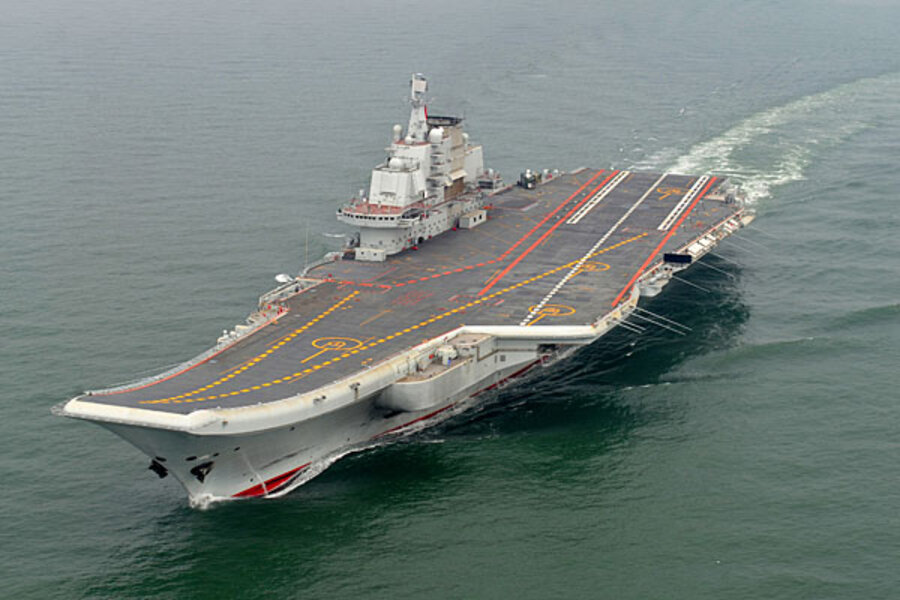China's first aircraft carrier: Is it any good?
Loading...
| Tokyo/Beijing
China sent its first aircraft carrier into formal service on Tuesday amid a tense maritime dispute with Japan in a show of force that could worry its neighbors.
China's Ministry of Defense said the newly named Liaoning aircraft carrier would "raise the overall operational strength of the Chinese navy" and help Beijing to "effectively protect national sovereignty, security, and development interests".
In fact, the aircraft carrier, refitted from a ship bought from Ukraine, will have a limited role, mostly for training and testing ahead of the possible launch of China's first domestically built carriers after 2015, analysts say.
China cast the formal handing over of the carrier to its navy – attended by President Hu Jintao and Premier Wen Jiabao – as a triumphant show of national strength at a time of tensions with Japan over islands claimed by both sides.
"The smooth commissioning of the first aircraft carrier has important and profound meaning for modernizing our navy and for enhancing national defensive power and the country's overall strength," Xinhua news agency cited Wen as saying at the commissioning ceremony in the northern port of Dalian.
Sino-Japanese relations deteriorated sharply this month after Japan bought the East China Sea islands, called Senkaku in Japan and Diaoyu in China, from their private owner, sparking anti-Japan protests across China.
"China will never tolerate any bilateral actions by Japan that harm Chinese territorial sovereignty," Vice Foreign Minister Zhang Zhijun told his Japanese counterpart on Tuesday as the two met in a bid to ease tensions.
"Japan must banish illusions, undertake searching reflection, and use concrete actions to amend its errors, returning to the consensus and understandings reached between our two countries' leaders."
In a sign of the tensions, China has postponed a ceremony marking the 40th anniversary of the resumption of diplomatic ties with Japan. But an official at the Japan-China Economic Association said Toyota Motor Corp chairman Fujio Cho and Hiromasa Yonekura, chairman of Japanese business lobby Keidanren, and other representatives of Japan-China friendship groups would attend an event on Thursday in Beijing. The risks of military confrontation are scant, but political tensions between Asia's two biggest economies could fester and worries persist about an unintended incident at sea.
"If blood is shed, people would become irrational," Koichi Kato, an opposition lawmaker who heads the Japan-China Friendship Association and will travel to Beijing, told Reuters.
"Not cutting edge"
For the Chinese navy, the addition of carriers has been a priority as it builds a force capable of deploying far from the Chinese mainland.
China this month warned the United States, with President Obama's "pivot" to Asia, not to get involved in separate territorial disputes in the South China Sea between China and US allies such as the Philippines.
U.S. Secretary of State Hillary Clinton in turn urged China and its Southeast Asian neighbors to resolve disputes "without coercion, without intimidation, without threats, and certainly without the use of force".
Narushige Michishita, a security expert at the National Graduate Institute for Policy Studies in Tokyo, said he thought the timing of the launch was unrelated to the islands dispute.
Rather, experts said it might be associated with China's efforts to build up patriotic unity ahead of a Communist Party congress that will install a new generation of top leaders as early as next month.
"China is taking another step to boost its strategic naval capability," Michishita said. "If they come to have an operational aircraft carrier, for the time being we are not super-concerned about the direct implications for the military balance between the US and Japan on the one hand, and China on the other. This is still not cutting edge."
The East China Sea tensions with Japan were complicated on Tuesday by the entry of Taiwan, the self-ruled island that Beijing calls an illegitimate breakaway, which also lays claim to the islands.
Japanese Coast Guard vessels fired water cannon to turn away about 40 Taiwan fishing boats and 12 Taiwan Coast Guard vessels. Six Chinese patrol ships were also near the islands but four left, leaving two nearby but not in waters Japan considers its own.
Japan protested to Taiwan, a day after lodging a complaint with China over what it called a similar intrusion by Chinese vessels.
Taiwan has friendly ties with Japan, but the two sides have long squabbled over fishing rights in the area. China and Taiwan both argue they have inherited China's historic sovereignty over the islands.
The flare-up in tension comes at a time when both China and Japan confront domestic political pressures. Japanese Prime Minister Yoshihiko Noda's government faces an election in months, adding pressure on him not to look weak on China. China's Communist Party is preoccupied with the leadership turnover, with President Hu Jintao due to step down.







